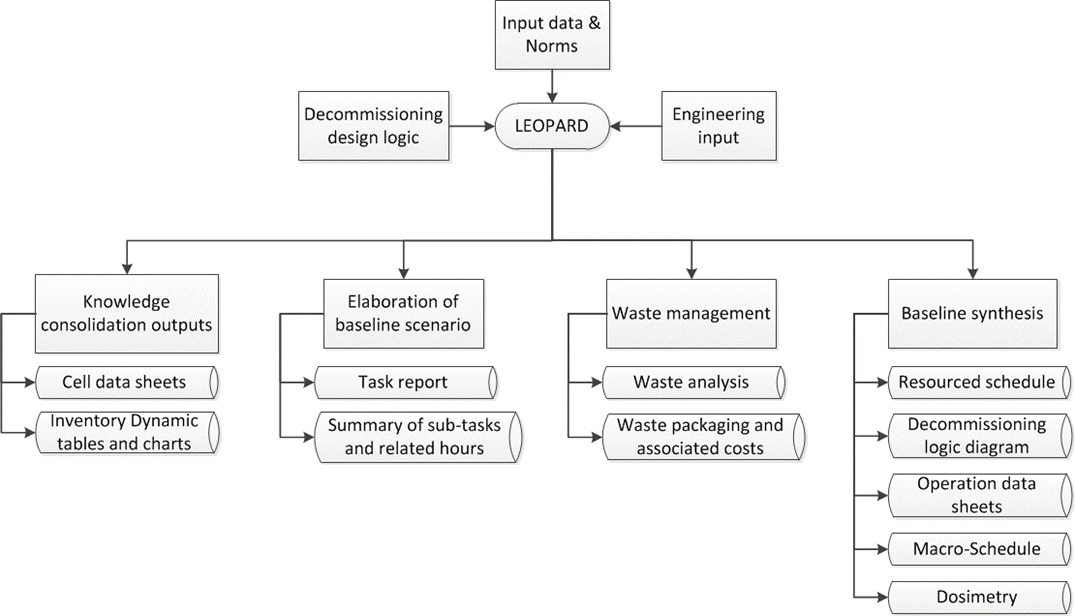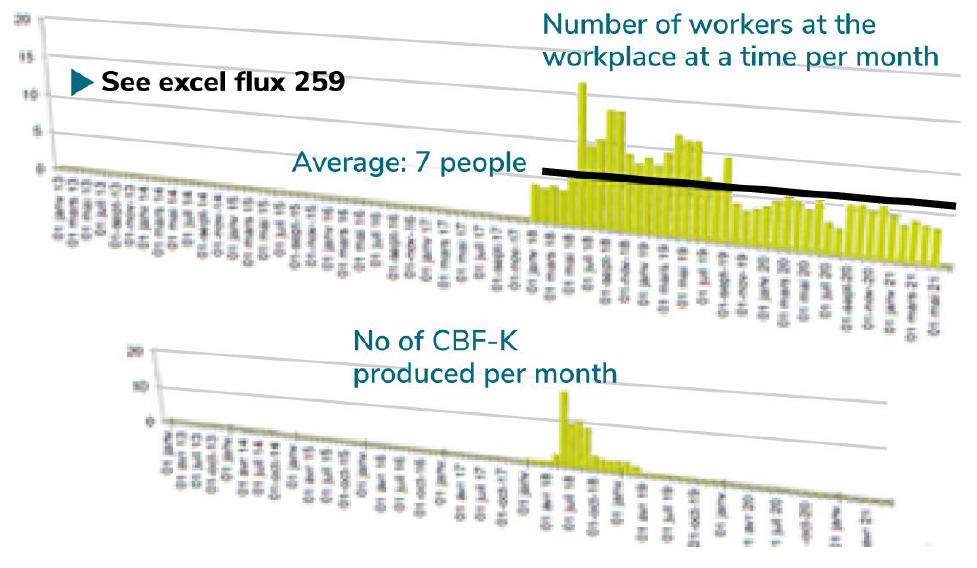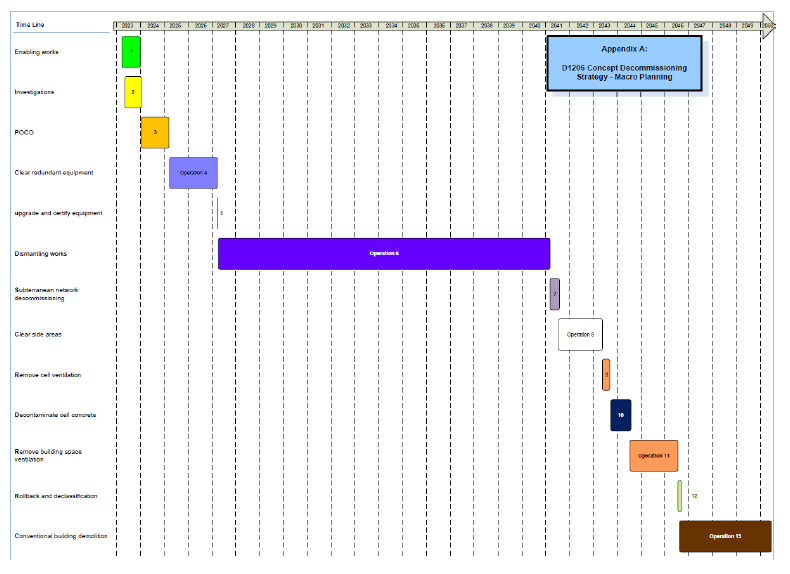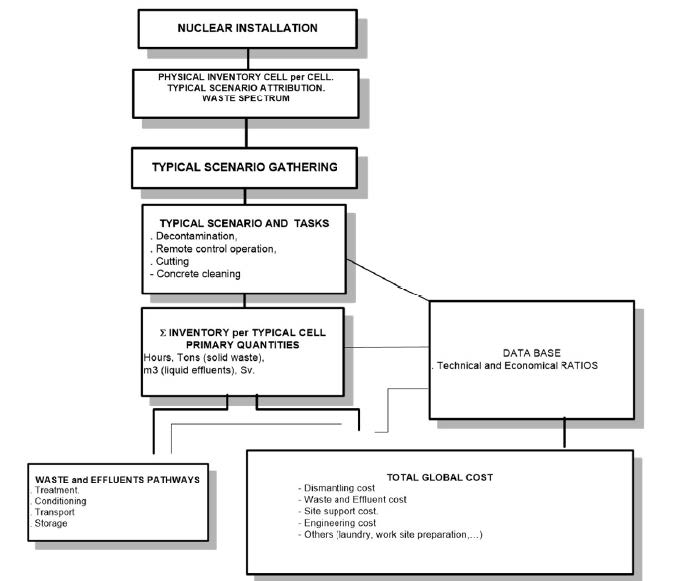LEOPARD - Software for Planning, Estimating and Monitoring of Large Decommissioning Projects

AUTHORS
Joe Faldowski, Don McGee
Orano Federal Services, LLC
PRESENTED
Feb. 28, 2023
Waste Management Symposia
ABSTRACT
Large, complex decommissioning projects require extensive planning on the front end and equally extensive monitoring throughout the execution phase to ensure all requirements are achieved. To support its D&D experts in meeting this objective, Orano has developed and refined a project management platform called LEOPARD Logiciel d’Elaboration et d’Optimisation des Programmes d’Assainissement Radiologique et de Démantèlement (Software for the Development and Optimization of Radiological Clean up and Dismantling Programs). LEOPARD combines all aspects of data management into a single, powerful tool that is used in all phases of a decommissioning project to properly plan, monitor, and optimize the key performance metrics of a major D&D project. It is a bottom-up decommissioning modelling tool that has been used extensively in France and the UK at major D&D projects. The tool is also used to audit decommissioning cost and schedule projections and has been audited by the French regulators.
LEOPARD is used to develop decommissioning baselines, compare scenarios, benchmark scenarios against parametric past performance data, and to monitor/optimize decommissioning progress in real-time. Detailed site data such as waste characterization and physical dimensions is collected and input into the program by expert users knowledgeable in both D&D and LEOPARD. At its core, LEOPARD is a centralized data management tool in a single IT platform containing all equipment details, characterization data, drawings, and process history. The software uses the site-specific data as an input to perform complex modelling and estimating functions that produce detailed reports and projections for planning and estimating purposes. LEOPARD uses NORMs or parametric data to generate meaningful projections of waste volumes, man hours, schedules and other useful project management functions used for planning, estimating and real time monitoring of the D&D project from beginning to end. Other benefits of LEOPARD are:

Figure 1. LEOPARD’s inputs and outputs
The first tool developed, prior to LEOPARD, was named “ETE Eval” and a parametric approach to establish cost estimates was utilized. To develop the input parameters needed, 16 typical workshop types were defined, a “standard scenario” was assigned to each workshop types, and libraries of norms (or unit cost factors) were defined. The combination of a plant inventory database (both physical and radiological), the application of typical scenarios, and the use of a library of ratios allowed the development of cost estimates for entire nuclear sites. Despite the apparent simplicity of the concept, the quality of the DCE resulted primarily in the experience of the engineers who were defining and applying the standard scenarios and the robustness of the unit cost factors.
Since mid-2006, the development and improvement of LEOPARD has been implemented and now enables the automatic management of all technical and financial data of D&D’s scenarios, while ensuring accurate traceability of the evolutions of an overall scenario. LEOPARD is actually a tool developed as an aid for the design and the optimization of overall D&D scenarios.

Figure 2. LEOPARD scenario development methodology
The most important point to note, though, is that the robustness of the final DCE resides in the proper application of the methodology, the experience of the engineer who established the functional scenario for each facility, and in the unit cost factors.
One major advantage of this approach is that it links a functional scenario with a cost estimate. A further advantage is that it allows users to estimate uncertainties and risks on the basis of physical and radiological inputs rather than approximations and or assumptions.
Improved waste profiling
The bottom-up approach provides a realistic estimate of how much waste will be produced and when.

Figure 3 Sample LEOPARD waste profile output
Optimization studies
LEOPARD provides the ability to modify assumptions used in the development of a D&D scenario to evaluate the positive or negative impacts of the change as compared to the baseline scenario. This feature allows the user to optimize the approach to best accommodate the limited resources whether it be staffing, waste containers, disposal options, or funding limitations. By performing this comparison of scenarios, the user can make informed decisions with a much higher degree of certainty as to the impact of modifications to future outcomes to achieve the best use of resources.
Early D&D planning
A live analytical approach to D&D planning using LEOPARD produces detailed plans that can be updated and changed as new data baselines are introduced or characterization data becomes available. This is a more substantiated, challengeable vision of how to decommission a facility. It can quickly show the difference in time and resources required depending on the information used for modeling. An entire site can benefit from using LEOPARD to provide a live plan that helps stakeholders and project teams understand interfaces and constraints and observe how a change of strategy in one area impacts another.
This analysis includes the following sequences:

Fig. 4: Typical block diagram of tasks sequencing logic

Figure 5: Cost estimation methodology
The primary types of outputs generated by LEOPARD include the following:
Due to its gradual construction, LEOPARD remains a flexible and adaptable tool; able to rapidly and easily take into account requirements and specificities of each type of site/facility.
Orano has begun the process of revising LEOPARD’s UK and French experiences that informed development of norms, unit factors, and terminology to a U.S.-based model that reflects U.S. waste disposal packaging and disposal methods. Also included in this revision is relevant U.S. experience on Radiological and IH controls, crew composition, and other applicable factors that are utilized to produce meaningful and accurate scenarios and the associated cost and schedule outputs. This service will be made available to U.S. facility managers interested in this type of information platform and its associated methodology to:
Other benefits of LEOPARD include:
Joe Faldowski, Don McGee
Orano Federal Services, LLC
PRESENTED
Feb. 28, 2023
Waste Management Symposia
ABSTRACT
Large, complex decommissioning projects require extensive planning on the front end and equally extensive monitoring throughout the execution phase to ensure all requirements are achieved. To support its D&D experts in meeting this objective, Orano has developed and refined a project management platform called LEOPARD Logiciel d’Elaboration et d’Optimisation des Programmes d’Assainissement Radiologique et de Démantèlement (Software for the Development and Optimization of Radiological Clean up and Dismantling Programs). LEOPARD combines all aspects of data management into a single, powerful tool that is used in all phases of a decommissioning project to properly plan, monitor, and optimize the key performance metrics of a major D&D project. It is a bottom-up decommissioning modelling tool that has been used extensively in France and the UK at major D&D projects. The tool is also used to audit decommissioning cost and schedule projections and has been audited by the French regulators.
LEOPARD is used to develop decommissioning baselines, compare scenarios, benchmark scenarios against parametric past performance data, and to monitor/optimize decommissioning progress in real-time. Detailed site data such as waste characterization and physical dimensions is collected and input into the program by expert users knowledgeable in both D&D and LEOPARD. At its core, LEOPARD is a centralized data management tool in a single IT platform containing all equipment details, characterization data, drawings, and process history. The software uses the site-specific data as an input to perform complex modelling and estimating functions that produce detailed reports and projections for planning and estimating purposes. LEOPARD uses NORMs or parametric data to generate meaningful projections of waste volumes, man hours, schedules and other useful project management functions used for planning, estimating and real time monitoring of the D&D project from beginning to end. Other benefits of LEOPARD are:
- Reduction in risk for long-term storage of electronic data by using fewer databases, and project teams can benefit from obtaining the relevant data from one source.
- Provides a method to maintain live-knowledge management to aid decommissioning activities.
- Provides a standard database per equipment, cell, or area to facilitate the storage of data across the site, which supports “bottom-up” decommissioning scenario planning.
- Provides a confidence or sensitivity analysis on the data to identify/evaluate if knowledge gaps are significant enough to affect the decommissioning models, which will support development of targeted investigation and characterization work to be implemented.
- Real-time parametric data can be used to update the norms in the system to show changes to schedules or reduction in tasks across the site planning schedule. This has been applied at Sellafield and where it was relevant, added to our current list
of norms.
- Standardized decommissioning scope to feed internal and external bases at a system level (ventilation, pipework, specific vessel).
- Standardization of reporting.
- The analytical approach presents the number of hours per task either at a system level, facility level, or site level.
- This has the potential to highlight techniques worth investing in to reduce risk to workers, to man-hours spent on a type of task, and ultimately to the cost for decommissioning the site overall.
- Allows planners and work group leaders to make informed decisions quicker with a high degree of confidence.

INTRODUCTION
Historically the ability to produce accurate and meaningful detailed cost and schedule estimates for large-scale radiological decommissioning projects has been very difficult due a variety of factors. Variables such as the lack of complete and accurate characterization data, uncertainties on the ultimate volumes and classifications of waste types, and the difficultly projecting the resource needs to plan and execute work in a safe and efficient manner all contribute to the challenge of producing accurate cost and schedule projections. In the early 1990s, decommissioning cost estimates (DCEs) were developed for fuel cycle, research facilities, and the future shutdown of UP1 as well as the Cadarache site in France. The objective of these initial DCEs was to establish budgets for the decommissioning of these sites. This effort covered a very large variety of facilities and workshops, from used fuel pools to hot cells, mechanical and chemical workshops, waste storage areas, etc. The refinement and updates of norms used by LEOPARD has been a continuous process from the initial use at Orano’s facilities in France to include development of norms and other factors at Dounreay and Sellafield facilities in the UK.The first tool developed, prior to LEOPARD, was named “ETE Eval” and a parametric approach to establish cost estimates was utilized. To develop the input parameters needed, 16 typical workshop types were defined, a “standard scenario” was assigned to each workshop types, and libraries of norms (or unit cost factors) were defined. The combination of a plant inventory database (both physical and radiological), the application of typical scenarios, and the use of a library of ratios allowed the development of cost estimates for entire nuclear sites. Despite the apparent simplicity of the concept, the quality of the DCE resulted primarily in the experience of the engineers who were defining and applying the standard scenarios and the robustness of the unit cost factors.
Since mid-2006, the development and improvement of LEOPARD has been implemented and now enables the automatic management of all technical and financial data of D&D’s scenarios, while ensuring accurate traceability of the evolutions of an overall scenario. LEOPARD is actually a tool developed as an aid for the design and the optimization of overall D&D scenarios.
CHALLENGES
A common issue or challenge encountered during the decommissioning of larger facilities is information sharing and configuration management between the various groups involved with the planning and execution of the work. Unfortunately, support groups tend to become stove-piped and the information they possess and subsequent requirements that are imposed are not known by all. Although not intentional, the end result is inefficient planning and performance exacerbated by the lack of access to key data vital to the development of an accurate D&D scenario. Characterization data, waste management requirements, radiological and IH controls as well as resource availability are all major factors that serve as key inputs for a meaningful plan that can be implemented successfully. As a planning tool LEOPARD forces a consolidation of all relevant information from the various support groups, not to mention the operational group responsible for performing the tasks. This results in a “single point of truth” for all decommissioning activities, thereby ensuring accuracy of cost and schedule estimates. Historically this process has been successfully demonstrated at our D&D projects in France and the UK and the favorable results speak for themselves. Essentially this approach minimizes surprises that typically result in delays, rework and poor utilization of resources. Regulatory authorities and independent financial auditors that oversee cost and progress at sites using LEOPARD have reviewed and validated the tool.APPLICATION OF THE TOOL
The LEOPARD approach was based on the development of functional scenarios for each of the facility types under the decommissioning perimeter program management team. These functional scenarios provided a detailed work breakdown structure for each facility, down to the level of single process equipment removal. These scenarios were then used to elaborate analytical cost estimates using Unit cost factors derived from the return on experience from past operations. This approach was then consolidated into a complete methodology, combining a plant inventory database, families of “functions” and “tasks,” unit cost factors, adjustment factors, and computer tools to facilitate the development and update of DCE for all of a given D&D site’s facilities. The overall approach used by LEOPARD is presented in graphic form in Figure 2 below:
The most important point to note, though, is that the robustness of the final DCE resides in the proper application of the methodology, the experience of the engineer who established the functional scenario for each facility, and in the unit cost factors.
One major advantage of this approach is that it links a functional scenario with a cost estimate. A further advantage is that it allows users to estimate uncertainties and risks on the basis of physical and radiological inputs rather than approximations and or assumptions.
Improved waste profiling
The bottom-up approach provides a realistic estimate of how much waste will be produced and when.
- Using these outputs, a work order can be adjusted to prevent “peaks and valleys” in resource requirements and waste production. This information allows work planners to level load job sequencing/scheduling to optimize the utilization of
the resources to the greatest extent possible (see figure 3 for example).
- At larger sites with multiple work locations, if all facilities are using LEOPARD, waste packaging, loading and transportation routes can be optimized for the entire site for a more efficient and centralized approach. An obvious benefit would be to minimize rehandling and repackaging of waste.

Optimization studies
LEOPARD provides the ability to modify assumptions used in the development of a D&D scenario to evaluate the positive or negative impacts of the change as compared to the baseline scenario. This feature allows the user to optimize the approach to best accommodate the limited resources whether it be staffing, waste containers, disposal options, or funding limitations. By performing this comparison of scenarios, the user can make informed decisions with a much higher degree of certainty as to the impact of modifications to future outcomes to achieve the best use of resources.
Early D&D planning
A live analytical approach to D&D planning using LEOPARD produces detailed plans that can be updated and changed as new data baselines are introduced or characterization data becomes available. This is a more substantiated, challengeable vision of how to decommission a facility. It can quickly show the difference in time and resources required depending on the information used for modeling. An entire site can benefit from using LEOPARD to provide a live plan that helps stakeholders and project teams understand interfaces and constraints and observe how a change of strategy in one area impacts another.
METHODOLOGY
In order to meet with client requirements and expectations for the development of cleaning up/dismantling scenarios, the methodology developed by Orano and its predecessors is based on a functional analysis of the work to be performed.This analysis includes the following sequences:
- Compilation and analysis of basic data inputs (radiological and technical status, inventories). These data also include transverse requirements: interfaces with the facilities in operations, ventilation, etc.
- Definition of the tasks to be carried out per room or hot cell. These actions are previously defined in a list including about 30 generic functions (from the definition of an initial condition of a pipe to the removal of a concrete structure).
- Issuance of a block diagram of the sequencing logics between these tasks. (see Figure 4)
- Issuance of the deliverables (schedule, waste flows, resources …).
- Gathering the tasks to set up the work packages. This progressive gathering takes into account the following requirements:
- Time - Duration shall not exceed two to three years, without any protracted period of inactivity between two cleanup/dismantling tasks of a same work package.
- Crafts / Qualifications - Identification of the tasks involving specific trades or trainings (i.e., remote operation) and gathering these tasks within a same work package.
- Size - The objective is to set up important work packages to simplify the management of the interface and cost optimization and to minimize the numbers of tenders or orders.
- Multiplicity - The total number of work packages should enable an easy overview of the financial breakdown for the dismantling of a facility: it should not exceed 30 to 40 work packages.
- Limiting the work area - The purpose is to limit the coactivity (interfaces, conflicts) between two work packages to be performed concurrently.
- Time - Duration shall not exceed two to three years, without any protracted period of inactivity between two cleanup/dismantling tasks of a same work package.

COST ESTIMATING
In terms of precision, the methodology implemented by LEOPARD is a “class 3” DCE, with an accuracy of -15%/+30% (refer to IAEA TECDOC-1476). The notion of accuracy should be considered with caution though, since it significantly depends on:- The level of detail and quality of the plant data available at the time of establishing the estimate.
- The level of detail and quality of the risk analysis which is associated to the DCE.

The primary types of outputs generated by LEOPARD include the following:
- Task sequencing logic diagram,
- Detailed project schedules and the associated resources,
- Various balances (waste inventories, volumes, dosimetry data)
- Throughputs in terms of production,
- Work packages estimates.
CONCLUSIONS
The collective experience and knowledge gained at various nuclear facility decommissioning projects over 16 years has been incorporated into LEOPARD’s database of unit factors, production rates, and other types of intelligence that are used to produce accurate D&D scenarios. The major benefits to this software platform are that it serves as a single source of knowledge or “truth” that assures the user of a detailed approach to a challenging D&D project that is continuously revised based on real-time updates to further improve the accuracy of the projection while also providing the oversight authority with a detailed, defensible estimate basis.Due to its gradual construction, LEOPARD remains a flexible and adaptable tool; able to rapidly and easily take into account requirements and specificities of each type of site/facility.
Orano has begun the process of revising LEOPARD’s UK and French experiences that informed development of norms, unit factors, and terminology to a U.S.-based model that reflects U.S. waste disposal packaging and disposal methods. Also included in this revision is relevant U.S. experience on Radiological and IH controls, crew composition, and other applicable factors that are utilized to produce meaningful and accurate scenarios and the associated cost and schedule outputs. This service will be made available to U.S. facility managers interested in this type of information platform and its associated methodology to:
- Benefit from the experience gained by Orano at its various nuclear decommissioning activities in France (Marcoule, La Hague, Cadarache) and in the UK (Sellafield and Dounreay)
- Improve cost efficiency by only focusing on D&D’s objectives and not on means to reach them
- Optimize D&D scenarios using the wide variety of options and criteria that LEOPARD performs in real time
Other benefits of LEOPARD include:
- Reduced risk associated with long-term data storage by using fewer databases so project teams can obtain data from a single source of truth
- Live knowledge management to facilitate D&D activities
- A standard database for equipment, cell, area, site, or complex to organize the storage and analysis of data at all levels
- Confidence or sensitivity analysis on the data to identify and evaluate significant knowledge gaps that need targeted investigation or characterization
REFERENCES
F. Pradoura, Setting Up A Decontamination And Dismantling (D&D) Scenario – Methodology And Tools Developed Leopard – 9194, WM 2009 Conference, March 2, 2009, Phoenix, AZRESOURCES
LEOPARD product flier>> Return to Orano White Papers
